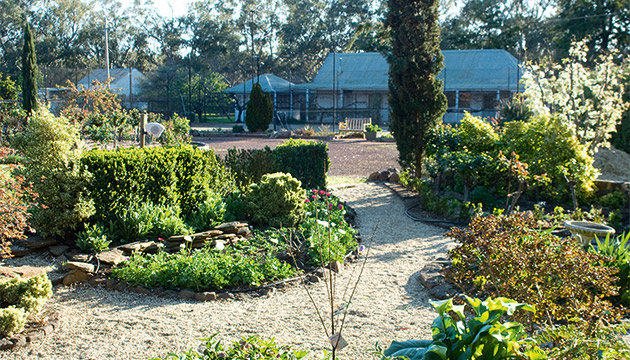After adapting from the cooler climes of Gippsland, Mary Wells has created a beautiful Riverina garden where tough trees shelter delicate plantings.
By Kathy Mexted
Nothing motivates like a daughter’s wedding and in 1989 this was the catalyst for Mary Wells to roll up her sleeves and finally take on the garden. “I didn’t have much time to achieve ‘wedding standard’ so I mass planted with colourful annuals and perennials,” she says. “This resulted in large areas of cottage garden, which was way more maintenance than I could consistently manage.” And so it was time to get serious and prepare a solid design for the two more weddings they’d host in the next four years.
When Graham Wells proposed to Mary in 1964 the two had joked about making plum jam in the home they would create together. Within two months “Tongala”, between Conargo and Jerilderie in the southern Riverina, NSW, came onto the market and, by the back door, stood a rare and productive black prince plum tree.
Tongala was established in 1904 and the generous homestead with its sweeping circular carriageway and expansive lawn and orchard were severely neglected by the time the Wells took over 60 years later. They renamed the property “One Oak” and relocated their successful Merino stud from Wedderburn, Vic. An English oak propagated from one on their original property is now a cornerstone of the Riverina garden.
“In 1964 I was presented with a once-gracious but now overgrown four-acre [1.6-hecatre] garden that was bounded on three sides by the Billabong Creek,” Mary says. “With very little gardening experience, the early years managing four children, live-in jackaroos and the revolving door of work-related guests left little time or energy for the daunting task of the rambling garden.”
In 1982 they built a new homestead on the front lawn and the old one was demolished. A sparse one-kilometre drive now cosies up to the south side of the wide Billabong Creek. It merges into the homestead’s east-facing front lawn, a lush oasis dappled with the shade of large Chinese and English elms and native willow, which provides a wispy welcome.
The drive winds through a stunning avenue of pleached elm underplanted with vibrant orange pigface and ice plant. It arrives at a cluster of original outbuildings and peels off to the right, wrapping around the house’s west.
This story excerpt is from Issue #86
Outback Magazine: Dec/Jan 2013










